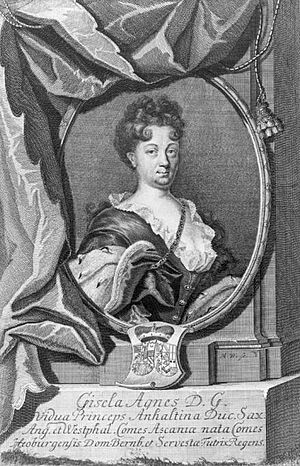Gisela Agnes of Rath facts for kids
Quick facts for kids Gisela Agnes of Rath |
|
|---|---|
 |
|
| Gisela Agnes of Rath | |
| Spouse(s) | Emmanuel Lebrecht, Prince of Anhalt-Köthen |
| Noble family | von Rath |
| Father | Balthasar William of Rath |
| Mother | Magdalene Dorothee of Wuthenau |
| Born | 9 October 1669 Kleinwülknitz, now part of Köthen |
| Died | 12 March 1740 (aged 70) Nienburg |
| Burial | St. Jacob church in Köthen |
Gisela Agnes of Rath (born October 9, 1669, in Kleinwülknitz, now part of Köthen – died March 12, 1740, in Nienburg) became a Duchess of Anhalt-Köthen in 1692 through her marriage. Later, in 1694, she was given the title Countess of Nienburg. From 1704 to 1715, she acted as the regent (a temporary ruler) of Anhalt-Köthen while her son was too young to rule.
Early Life and Marriage
Gisela Agnes came from an old noble family who followed the Lutheran faith. Her parents were Balthasar William of Rath-Kleinwülknitz and Magdalene Dorothea of Wuthenau. Her grandfather, Wilhelm von Rath, was a military commander. He led the army for Prince Louis I of Anhalt-Köthen during the Thirty Years' War.
The young Prince Emmanuel Lebrecht of Anhalt-Köthen, who was next in line to rule, fell in love with Gisela Agnes. His mother, Princess Eleonore, tried to stop their relationship. This was because Gisela Agnes was from a less powerful noble family. She was not considered suitable to marry a ruling Prince. Princess Eleonore even sent Gisela Agnes away to her sister.
However, as soon as Emmanuel Lebrecht became the ruler, he secretly married Gisela Agnes on September 30, 1692. This marriage was considered a "morganatic marriage." This meant that even though they were married, Gisela Agnes and their children would not automatically inherit his royal titles or privileges.
Also, Prince Emmanuel Lebrecht was a Calvinist, and Gisela Agnes was Lutheran. These were different branches of the Protestant church. Their marriage caused strong protests from both the Calvinist church and the princely family. Despite this, the children from their marriage were officially recognized as future heirs to the throne. This happened in 1698 by the Princes of Anhalt and in 1699 by the Emperor. All the later Dukes of Anhalt-Köthen came from this "unequal" marriage.
Gisela Agnes as Regent
Before he died, Prince Emmanuel Lebrecht made plans for Gisela Agnes to become the regent for their son Leopold. So, when her husband passed away in 1704, she took on the role of ruler.
As regent, Gisela Agnes supported the Lutherans in the principality. She founded the St. Agnus church in Köthen, which was the first Lutheran church there. A large painting of her by Antoine Pesne can still be seen in this church. A few years later, the famous composer Johann Sebastian Bach would join this church. In 1711, she also started the Gisela Agnes Stift. This was a special home for single noble ladies.
In 1714, a court orchestra was created. Gisela Agnes formally started it, but her son Leopold paid for it. At first, the orchestra was mostly made up of musicians from Berlin. Their old orchestra had been closed the year before. The first leader of the orchestra was Augustin Reinhard Stricker. In 1717, he was replaced by Johann Sebastian Bach.
In 1694, Emperor Leopold I gave Gisela Agnes the title "Countess of Nienburg." In 1699, Emmanuel Lebrecht gave her the castle, city, and area of Nienburg as her own property for life. When her time as regent ended in 1715, Gisela Agnes moved to Nienburg. There, she continued to support the Lutheran faith. She became friends with the religious scholar and poet August Hermann Francke. He even visited her at her home in Nienburg.
On January 24, 1716, her daughter Eleonore Wilhelmine married Duke Ernest Augustus I of Saxe-Weimar-Eisenach in Nienburg. Many people believe that her son Leopold first met the composer Bach during these wedding celebrations.
Gisela Agnes died in Nienburg on March 12, 1740. She was buried in the princely crypt at the St. Jacob church in Köthen.
Children
Gisela Agnes and Emmanuel Lebrecht had six children:
- Augustus Lebrecht (1693)
- Leopold, Prince of Anhalt-Köthen (1694–1728)
- Eleonore Wilhelmine (1696–1726)
- Augustus Louis, Prince of Anhalt-Köthen (1697–1755)
- Gisela Auguste (1698)
- Christiane Charlotte (1702–1745)

